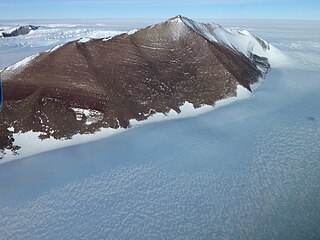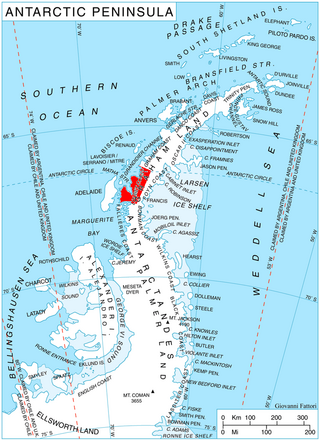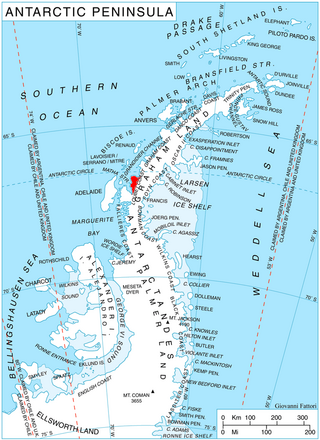Related Research Articles
The Geologists Range is a mountain range about 55 km (34 mi) long, standing between the heads of Lucy and Nimrod Glaciers in Antarctica. Seen by the northern party of the New Zealand Geological Survey Antarctic Expedition (NZGSAE) (1961–62) and named to commemorate the work of geologists in Antarctic exploration. The Churchill Mountains are to the north, the Queen Elizabeth Range to the east and the Miller Range to the southeast

The Pensacola Mountains are a large group of mountain ranges and peaks that extend 280 nautical miles in a northeast–southwest direction in the Transantarctic Mountains System, Queen Elizabeth Land region of Antarctica. They comprise the Argentina Range, Forrestal Range, Dufek Massif, Cordiner Peaks, Neptune Range, Patuxent Range, Rambo Nunataks and Pecora Escarpment. These mountain units lie astride the extensive Foundation Ice Stream and Support Force Glacier which drain northward to the Ronne Ice Shelf.
The Patuxent Range is a major range of the Pensacola Mountains, Antarctica. It comprises the Thomas Hills, Anderson Hills, Mackin Table and various nunataks and ridges bounded by the Foundation Ice Stream, Academy Glacier and the Patuxent Ice Stream.
The Amundsen Glacier is a major Antarctic glacier, about 7 to 11 km wide and 150 km (80 nmi) long. It originates on the Antarctic Plateau where it drains the area to the south and west of Nilsen Plateau, then descends through the Queen Maud Mountains to enter the Ross Ice Shelf just west of the MacDonald Nunataks.

Minnesota Glacier is a broad glacier, about 40 nautical miles long and 5 nautical miles wide, flowing east through the Ellsworth Mountains in Antarctica, separating the Sentinel Range and the Heritage Range. It is nourished by ice from the plateau west of the mountains and by Nimitz Glacier and Splettstoesser Glacier, and merges into the larger Rutford Ice Stream at the eastern margin of the Ellsworth Mountains.
Tucker Glacier is a major valley glacier of Victoria Land, Antarctica, about 90 nautical miles long, flowing southeast between the Admiralty Mountains and the Victory Mountains to the Ross Sea. There is a snow saddle at the glacier's head, just west of Homerun Range, from which the Ebbe Glacier flows northwestward.

The Prince Charles Mountains are a major group of mountains in Mac. Robertson Land in Antarctica, including the Athos Range, the Porthos Range, and the Aramis Range. The highest peak is Mount Menzies, with a height of 3,228 m (10,591 ft). Other prominent peaks are Mount Izabelle and Mount Stinear. These mountains, together with other scattered peaks, form an arc about 420 km (260 mi) long, extending from the vicinity of Mount Starlight in the north to Goodspeed Nunataks in the south.
Sherwin Peak is a peak, 2,290 metres (7,510 ft) high, surmounting the east side of Otago Glacier 5 nautical miles southeast of Mount Chivers, in the north part of the Queen Elizabeth Range, Antarctica.
William Glacier is a glacier flowing south from the interior highlands of Anvers Island to the head of Börgen Bay on the southeast coast of the island, in the Palmer Archipelago. Discovered by the Belgian Antarctic Expedition, 1897–99, under Gerlache, and charted by them simply as a "grand glacier." The name William Glacier first appears on a chart based upon a 1927 survey by DI personnel on the Discovery. Gateway Ridge separates William Glacier from Hooper Glacier.

Ambergris Glacier is a glacier flowing south-southeast from Mount Sara Teodora between Chintulov Ridge and Valkosel Ridge to join Flask Glacier just west of Fluke Ridge in Aristotle Mountains on the east coast of Graham Land, Antarctica. One of several names in the area that reflect a whaling theme, it was named in 1987 by the United Kingdom Antarctic Place-Names Committee from the substance secreted by the sperm whale and used in perfumery.

Bulkington Pass is a pass on the south side of Flask Glacier and west of Bildad Peak in Voden Heights on the east side of Graham Land. The pass trends northeast–southwest for 4 nautical miles (7 km) and provides a route from the ice piedmont north of Adit Nunatak to Flask Glacier. The toponym is one in a group applied by the UK Antarctic Place-Names Committee that reflects a whaling theme, Bulkington being a crewman on the vessel Pequod in Herman Melville's Moby Dick.
The Nash Range is a mainly ice-covered coastal range in the Churchill Mountains of Antarctica.
Svaton Peaks is a cluster of rugged peaks at the north end of the Queen Elizabeth Range, Antarctica, surmounting the area between the mouths of the Heilman Glacier and Otago Glacier.

Frigga Peak is a peak, 1,570 metres (5,150 ft) high, which stands at the south side of Anderson Glacier on the east coast of Graham Land, Antarctica. It was charted by the Falkland Islands Dependencies Survey (FIDS) and photographed from the air by the Ronne Antarctic Research Expedition in 1947. The FIDS named it after the Norse goddess Frigga, the "cloud spinner," because clouds were observed to form on the summit of this peak earlier than on any other feature in this vicinity. Nearby Mount Odin was named in association, since Odin is Frigga's wife in Norse mythology.

Drummond Glacier is a glacier 10 nautical miles (18 km) long and 2 nautical miles (4 km) wide, on the west coast of Graham Land, situated south of Hopkins Glacier and flowing west-northwest between Voit Peak and Sherba Ridge into Darbel Bay east of Sokol Point.

McCance Glacier is the 30-km long and 5 km wide glacier draining the Hutchison Hill area on the west slopes of Avery Plateau on Loubet Coast in Graham Land, Antarctica. It flows north-northwestwards along the west side of Osikovo Ridge, Kladnitsa Peak and Rubner Peak and enters Darbel Bay.

Kornicker Glacier is a glacier draining northeastwards from the cirque bounded by Mount Liptak, Mount Southwick, Mount Milton and Mount Mullen in the southern Sentinel Range of the Ellsworth Mountains in Antarctica. The glacier flows along the northwestern side of Petvar Heights and merges with the terminus of the southeast-flowing Thomas Glacier as both glaciers emerge from the range.

Bender Glacier is a glacier that flows from Mount Atkinson and Mount Craddock southwards between Chaplin Peak and Krusha Peak, and joins Nimitz Glacier just south of Gilbert Spur in the southern Sentinel Range, Ellsworth Mountains in Antarctica. Receiving ice influx from its left tributaries Severinghaus Glacier, Brook Glacier and Bolgrad Glacier.

Cervellati Glacier is a 5 nmi long glacier situated on the southeast of Patton Glacier and northwest of Ramorino Glacier on the east slope of Sentinel Range in the Ellsworth Mountains, Antarctica. It flows northeastwards between Tyree Ridge and Epperly Ridge, and enters Crosswell Glacier southeast of Mount Bearskin. The feature was named by US-ACAN in 2006 after Roberto Cervellati, Italian representative to the SCAR Expert Group on Geographic Information, 1992–2006, and director of the SCAR Composite Gazetteer of Antarctica in the same period.

Mount Warren is a mountain rising to 2,340 metres (7,680 ft) in Gromshin Heights, just north of the turn in Newcomer Glacier on the east side of northern Sentinel Range in Ellsworth Mountains, Antarctica. It surmounts Newcomer Glacier to the west and south, and Vicha Glacier to the northeast.
References
- ↑ "Jeffries Peak". Geographic Names Information System . United States Geological Survey, United States Department of the Interior . Retrieved 2012-07-23.
![]() This article incorporates public domain material from "Jeffries Peak". Geographic Names Information System . United States Geological Survey.
This article incorporates public domain material from "Jeffries Peak". Geographic Names Information System . United States Geological Survey.